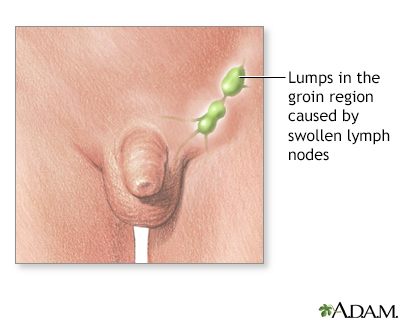Groin lump
Lump in the groin; Inguinal lymphadenopathy; Localized lymphadenopathy - groin; Bubo; Lymphadenopathy - groin
A groin lump is swelling in the groin area. This is where the upper leg meets the lower abdomen.

The lymphatic system filters fluid from around cells. It is an important part of the immune system. When people refer to swollen glands in the neck, they are usually referring to swollen lymph nodes. Common areas where lymph nodes can be easily felt, especially if they are enlarged, are the groin, armpits (axilla), above the clavicle (supraclavicular), in the neck (cervical), and the back of the head just above hairline (occipital).

Lymph nodes play an important part in the body's defense against infection. Swelling might occur even if the infection is trivial or not apparent. Swelling of lymph nodes generally results from localized or systemic infection, abscess formation, or malignancy. Common areas where the lymph nodes can be felt include the groin area, armpit, the neck, under the jaw and chin, behind the ears, and below the occiput (prominence on the back of the head). As a rule, when swelling appears suddenly and is painful, it is usually caused by injury or an infection. Enlargement that comes on gradually and painlessly may result from malignancy or tumor.
Considerations
A groin lump may be firm or soft, tender, or not painful at all. Your health care provider should examine any groin lumps.
Causes
The most common cause of a groin lump is swollen lymph nodes. These may be caused by:
- Cancer, most often lymphoma (cancer of the lymph system)
- Infection in the legs
- Body-wide infections, often caused by viruses
- Infections spread through sexual contact such as genital herpes, chlamydia, or gonorrhea
Other causes include any of the following:
Home Care
Follow the treatment your provider prescribed.
When to Contact a Medical Professional
Small lymph nodes that can be felt in the groin are common, especially in men, and usually result from prior leg infection. Make an appointment to see your provider if you have an unexplained groin lump.
What to Expect at Your Office Visit
Your provider will examine you and may feel the lymph nodes in your groin area. A genital or pelvic exam may be done.
You will be asked about your medical history and symptoms, such as when you first noticed the lump, whether it came on suddenly or slowly, or whether it gets larger when you cough or strain. You may also be asked about your sexual activities.
Tests that may be done include:
- Blood tests such as a CBC or blood differential
- Blood tests to check for syphilis, HIV, or other sexually transmitted infections
- Kidney function tests
- Liver function tests
- Liver spleen scan
- Abdominal and pelvic ultrasound
- Abdominal and pelvic CT scan
- Lymph node biopsy
References
McGee S. Peripheral lymphadenopathy. In: McGee S, ed. Evidence-Based Physical Diagnosis. 5th ed. Philadelphia, PA: Elsevier; 2022:chap 27.
Poulose BK, Carbonell AM, Rosen MJ. Hernias. In: Townsend CM, Beauchamp RD, Evers BM, Mattox KL, eds. Sabiston Textbook of Surgery. 21st ed. Elsevier; 2022:chap 45.
Winter JN. Approach to the patient with lymphadenopathy and splenomegaly. In: Goldman L, Cooney KA, eds. Goldman-Cecil Medicine. 27th ed. Philadelphia, PA: Elsevier; 2024:chap 154.
Version Info
Last reviewed on: 7/23/2024
Reviewed by: Linda J. Vorvick, MD, Clinical Professor, Department of Family Medicine, UW Medicine, School of Medicine, University of Washington, Seattle, WA. Also reviewed by David C. Dugdale, MD, Medical Director, Brenda Conaway, Editorial Director, and the A.D.A.M. Editorial team.
